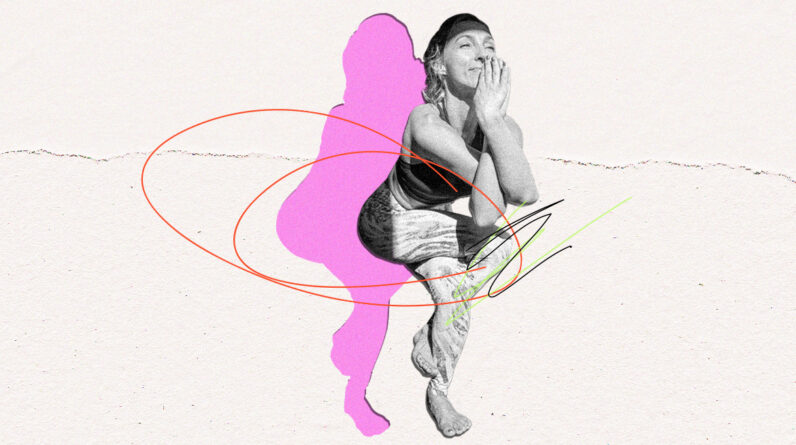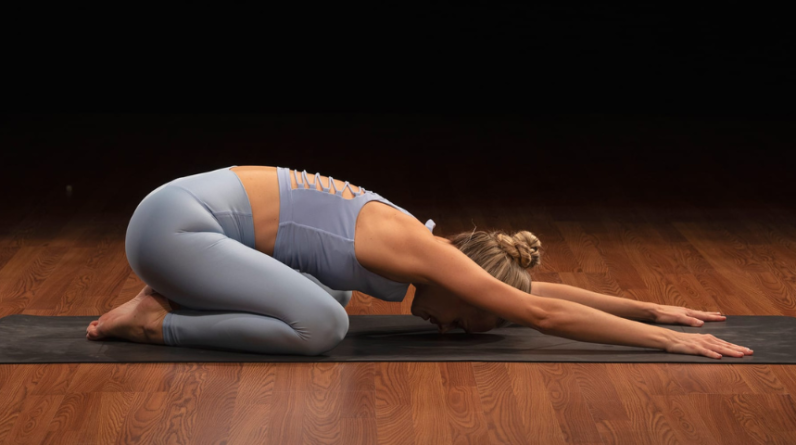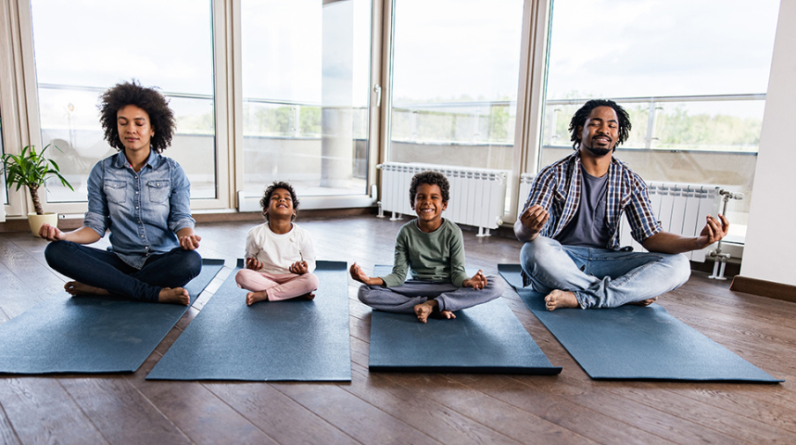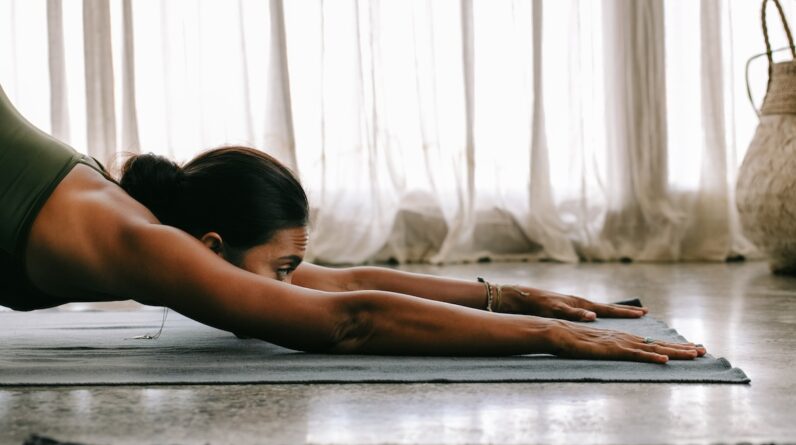
At its most basic, eagle pose appears to be another one-legged balance asana, but it’s actually a journey toward freedom.
“The eagle yoga pose, garudasana, is associated not only with an animal but also with a god named Garuda, described as having a golden body, white face, red wings, talons, and a curved beak,” writes author and yoga teacher Alison Zak in her recent book, Wild Asana: Animals, Yoga, and Connecting Our Practice to the Natural World. “He reigns as king of the birds in Hindu mythology and symbolizes integrity because he once carried the nectar of immortality in his beak without drinking a drop of what was not rightfully his.”
There are three distinct parts to the pose. The first is remaining upright. In the second part we curl into the nest of our legs, which engages the abdominals. The final part is the coming out of the pose, where we spread our wings and “fly away.”
Eagle can also be broken up into upper and lower halves and then sprinkled into other yoga asanas. The arms and upper body can be practiced in a variety of alternative poses, like the warrior poses or half moon.
“I love to teach eagle arms in poses such as goddess or even seated in virasana or vajrasana,” says Neeti Narula, a popular yoga guide on the Melissa Wood Health app.
The legs can be added to any inversion, like handstand and headstand, to spruce it up a bit. This is how Los Angeles–based teacher and co-owner of Yoga Sanctum, Audrey Rey Espinosa, loves exploring the posture: “I love coming into a tripod headstand with eagle legs and then straddle, switching legs mid-air!”
Regardless if you choose to keep one talon on the ground, eagle teaches us how to find freedom and spaciousness—both in flight and in the confines of the nest.
Benefits of eagle pose
Balance improvement
“This is the perfect pose to work your body for balance,” says Espinosa, but it’s not as simple as balancing on one leg. There is a dynamism to the balance requirements as you move between stages. Moving through the stages is also a sure-fire concentration boost. It’s hard to think about anything else when you’re focusing on not falling.
“[Do your] best to bring awareness to the foot that is on the ground, and root down through all four corners—the inner and outer heel, and the mound under the big toe, as well as the mound under the pinky toe,” recommends Brian Hyman, RYT, IAYT, author of Recovery with Yoga.
Leg strengthening
There are a number of yoga asana that strengthen our outer hips—but not eagle pose. It lengthens our outer hips and glutes and strengthens our inner thigh muscles, our adductors.
“Eagle is a go-to counterpose after doing a series of external hip shapes,” says Espinosa, who has battled with a hypermobile pelvis and sacrum since giving birth eight years ago. “This asana helps me rehabilitate and feel balanced and strong after doing a lot of warrior poses.”
Upper-body stretch
The arm position, even when modified, provides a delicious upper-body stretch in our back and shoulders, particularly the rhomboids, which bring the shoulder blades together. Narula teaches the prenatal program at Melissa Wood Health and loves focusing on this benefit with her pregnant students: “Eagle arms can feel really wonderful during pregnancy as our backs and shoulders are in need of opening!” It’s also a wonderful stretch for our fascia, and eagle arms is known to be an excellent yoga pose for headaches.
Agility improvement
The various phases of eagle require a lot of agility. From the beginning, you are weaving parts of your body together while balancing on one foot. Then you have to maintain the wrap while you round down and in, only to reverse it all to come out of the pose. Eagle also asks us to hug in with certain areas, but expand in others. All of these seemingly contradictory asks require agility and an ability to move with nuance.
Breath control
Moving between the upright version to the curled in version is an opportunity for us to practice maintaining a steady breath, regardless of circumstance. That said, the phase where we are “nesting” can be challenging for people with histories of anxiety, warns Espinosa, who has experienced shortness of breath in the posture. “Start slow and make your breath the most important piece,” she advises.
How to do eagle pose
- Start in chair pose with your feet together, knees bent, and weight in your heels.
- Lift your left leg and cross it over your right, so your thighs are stacked.
- If you’re able, tuck your left foot behind your right ankle.
- Inhale your arms into a wide T-shape.
- Now cross the opposite arm on top: Right elbow over left.
- Bend at your elbows, bringing your forearms perpendicular to the floor.
- Cross at your wrists to connect your palms together (or press the backs of the hands together)
- This is part 1: Upright eagle.
- Take an inhale, then as you exhale, begin to curl your spine forward.
- Imagine touching the front of your knees with your elbows. It’s okay if you don’t get all the way down.
- Keep your shoulders sliding out of your ears and maintain a broad chest.
- Bow your head, tucking your chin into your chest.
- This is part 2: Nesting eagle.
- Hold here for 5 breaths.
- Coming out, first return to upright eagle on an inhale and pause there to exhale.
- Untangle your top leg, passing back through chair pose.
- Untangle your arms and slowly stand up to mountain pose.
- Set up for your second side.
How to modify eagle pose for beginners
Although eagle can be classified as one of the basic yoga poses, our proportions and balance can make it advanced really quickly. Using props and/or backing off is a great way to land your eagle in order to fit your needs.
Plus, as Narula says, “sometimes the ‘modifications’ can actually be more physically challenging than the bound and/or balance version because without the distraction of trying our best to stay upright, we have to stay honest.”
Beginner doesn’t mean “easy” or “less than,” it simply means you are still learning the pose.
Kickstand your bottom foot or place your toes on a block
Reminder that finding the right asana alternative is all about what works for your body.
“My relationship with the posture has definitely changed over the years. When I first began practicing yoga, I was extremely focused on getting very deep into the bind aspects of the posture,” says Narula. “Today, I often use the foot of my top leg as added balance support rather than taking my toes behind the opposite calf. I find that this way feels more spacious and allows me to feel more aligned in the posture, creating that steadiness and ease quality that is essential to any asana.”
Give yourself a hug or press your forearms together
The wrapping of the arms, like many twisting yoga poses, can be a challenge for a variety of reasons, whether that’s your natural body proportions or even injury.
“Try arm variations, such as grabbing opposite shoulders, rather than the traditional arms,” suggests Narula. This will create a similar opening in the upper back, without overly taxing the shoulders.
If you need to avoid the wrapping altogether, you can always press palms and forearms together. “The forearms together variation creates space between the shoulder blades, where tension and stress is stored within the body, so that would be a good way to let go of the weight of the world that we carry there,” says Hyman.
Quick tips for mastering eagle pose
There are some common misalignments in eagle which can be remedied with tiny adjustments.
Keep your weight in your standing heel
Once the legs start to wrap, there’s a tendency to bring all our weight toward our standing toes, which can make balance more precarious, especially if you choose to nest. Once in the pose, really sit back with the hips, bringing more weight into your standing heel.
“Without a stable connection to the ground, which provides the foundation for eagle pose, sensations of freedom and lightness that allow us to feel that we are rising above the circumstances of life will unlikely be cultivated or maintained,” explains Hyman.
Press your top elbow down, as you lift your bottom elbow up
Eagle benefits from a lot of opposite actions. One such action is the top upper arm bone pressing down into the bottom upper arm bone, as your bottom upper arm bone gently lifts toward your head. This upper arm tug-of-war helps glide the shoulder blades down your back.
Hollow the belly to nest more deeply
Many people try to fold flat to nest their eagle and miss the nest entirely. Take a huge exhale and really round your spine in order to bring your elbows to your top thighs. This will hollow your belly and allow you to tuck you in nicely.
Put your inner thighs to work
Narula loves to cue students to “squeeze their inner thighs together gently, which naturally helps bring the low belly online and elongates the low back rather than sticking the tailbone out.”
Eagle pose variations
1. Supine eagle
If balance is a real challenge, supine eagle is a great way to get the binding benefits of pose without needing to stand.
- Start on your back with your knees bent and feet on the floor.
- Cross your left leg over your right, like you’re sitting at a desk chair.
- Lift your shins so they are parallel to the floor.
- If possible, double cross your left toes behind your right ankle.
- Cross your arms over your chest with your right arm over your left.
- Double-cross to either press the backs of the hands together or cross at wrists to touch palms.
- Touch your toes toward the earth and your fingertips overhead for a lovely spine stretch.
- Untangle and repeat on your opposite side.
2. Eagle crunch
Want some extra core work? Try adding the eagle crunch to your flow.
- From supine eagle, inhale first. On an exhale, curl your spine, bringing your knees and elbow together.
- Inhale return to supine eagle.
- Repeat 5 full rounds.
- Once complete, untangle your limbs and pause before doing side two.
3. Prenatal version
This prenatal eagle helps create more space for growing bellies, and is also a great option if you have hip injuries.
- Stand near a wall with your feet hip-width apart. The wall is there for balance.
- Sit back into chair pose, with your feet together, hips back, and knees bent.
- Cross your right ankle over your left leg, coming into figure-4 legs.
- Take the arms into eagle: crossing left elbow over right and crossing once more at wrists.
- If the upper body portion is feeling too constricting with your growing belly, consider one of the optional arms variations listed above (such as elbows pressing together or giving yourself a hug).
- Hold for 3 breaths.
- Untangle the arms and legs and stand up.
- Repeat with the other leg and arm on top.
Reasons you might want to skip eagle
Pregnancy
Eagle is generally contraindicated for pregnant people. “In eagle, the legs crossed makes for a very narrow center, so balance becomes especially difficult,” says Narula, who runs a prenatal program for the Melissa Wood Health app. “Additionally, the top leg crossing over the bottom leg may can create pressure and restriction against the lower part of the belly in later pregnancy”
Eagle pose is also not a hip opener—it’s primarily internal rotation, which is the opposite of what you’ll want to focus on during pregnancy. Hip openers “prepare us for birth, such as those involving external rotation or our hips,” says Narula.
Shoulder injury
Shoulder injuries can prohibit people from getting their arms across their chest. “If you cannot take the full arm wrap in eagle pose, a bear hug is an option,” suggests Hyman. “The hands can also be brought to the heart as yet another option. These alternatives are beneficial because they avoid further pain or worsening of injuries, while yogis simultaneously get a chance to find their own personal practice.”
Hip injury
“Eagle legs are a great way to engage the inner leg and pelvis adductor muscles that help stabilize the femur bone in the hip socket, but this may not serve anyone who has groin pain or injuries in the Iliopsoas like bursitis or tendonitis,” says Espinosa. If you’re dealing with hip injuries, skip the legs or substitute with the figure-4 option mentioned in the prenatal version.












